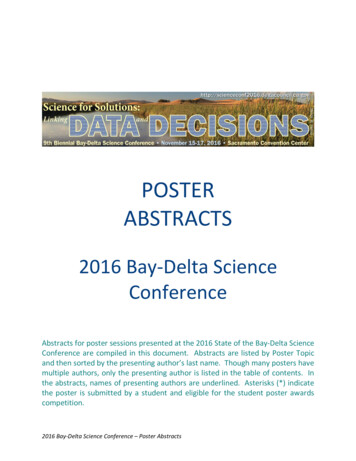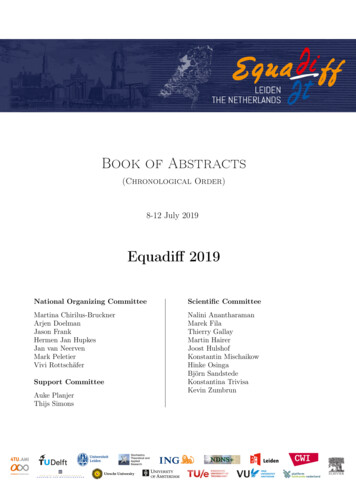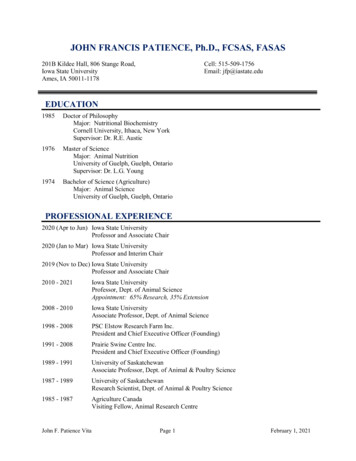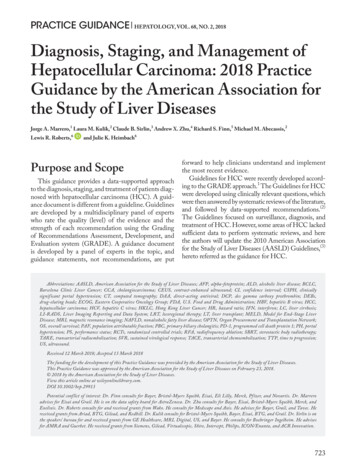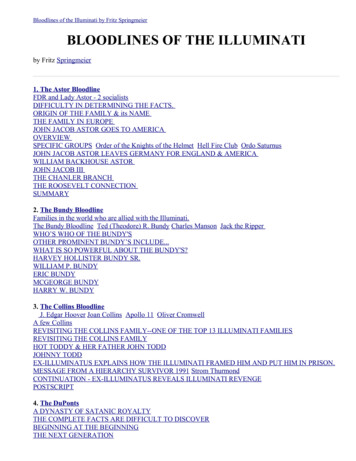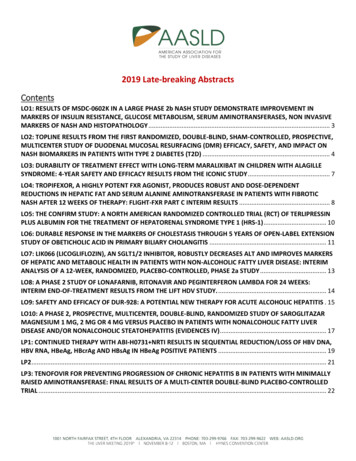
Transcription
2019 Late-breaking AbstractsContentsLO1: RESULTS OF MSDC-0602K IN A LARGE PHASE 2b NASH STUDY DEMONSTRATE IMPROVEMENT INMARKERS OF INSULIN RESISTANCE, GLUCOSE METABOLISM, SERUM AMINOTRANSFERASES, NON INVASIVEMARKERS OF NASH AND HISTOPATHOLOGY . 3LO2: TOPLINE RESULTS FROM THE FIRST RANDOMIZED, DOUBLE-BLIND, SHAM-CONTROLLED, PROSPECTIVE,MULTICENTER STUDY OF DUODENAL MUCOSAL RESURFACING (DMR) EFFICACY, SAFETY, AND IMPACT ONNASH BIOMARKERS IN PATIENTS WITH TYPE 2 DIABETES (T2D) . 4LO3: DURABILITY OF TREATMENT EFFECT WITH LONG-TERM MARALIXIBAT IN CHILDREN WITH ALAGILLESYNDROME: 4-YEAR SAFETY AND EFFICACY RESULTS FROM THE ICONIC STUDY . 7LO4: TROPIFEXOR, A HIGHLY POTENT FXR AGONIST, PRODUCES ROBUST AND DOSE-DEPENDENTREDUCTIONS IN HEPATIC FAT AND SERUM ALANINE AMINOTRANSFERASE IN PATIENTS WITH FIBROTICNASH AFTER 12 WEEKS OF THERAPY: FLIGHT-FXR PART C INTERIM RESULTS . 8LO5: THE CONFIRM STUDY: A NORTH AMERICAN RANDOMIZED CONTROLLED TRIAL (RCT) OF TERLIPRESSINPLUS ALBUMIN FOR THE TREATMENT OF HEPATORENAL SYNDROME TYPE 1 (HRS-1) . 10LO6: DURABLE RESPONSE IN THE MARKERS OF CHOLESTASIS THROUGH 5 YEARS OF OPEN-LABEL EXTENSIONSTUDY OF OBETICHOLIC ACID IN PRIMARY BILIARY CHOLANGITIS . 11LO7: LIK066 (LICOGLIFLOZIN), AN SGLT1/2 INHIBITOR, ROBUSTLY DECREASES ALT AND IMPROVES MARKERSOF HEPATIC AND METABOLIC HEALTH IN PATIENTS WITH NON-ALCOHOLIC FATTY LIVER DISEASE: INTERIMANALYSIS OF A 12-WEEK, RANDOMIZED, PLACEBO-CONTROLLED, PHASE 2a STUDY . 13LO8: A PHASE 2 STUDY OF LONAFARNIB, RITONAVIR AND PEGINTERFERON LAMBDA FOR 24 WEEKS:INTERIM END-OF-TREATMENT RESULTS FROM THE LIFT HDV STUDY. . 14LO9: SAFETY AND EFFICACY OF DUR-928: A POTENTIAL NEW THERAPY FOR ACUTE ALCOHOLIC HEPATITIS . 15LO10: A PHASE 2, PROSPECTIVE, MULTICENTER, DOUBLE-BLIND, RANDOMIZED STUDY OF SAROGLITAZARMAGNESIUM 1 MG, 2 MG OR 4 MG VERSUS PLACEBO IN PATIENTS WITH NONALCOHOLIC FATTY LIVERDISEASE AND/OR NONALCOHOLIC STEATOHEPATITIS (EVIDENCES IV) . 17LP1: CONTINUED THERAPY WITH ABI-H0731 NRTI RESULTS IN SEQUENTIAL REDUCTION/LOSS OF HBV DNA,HBV RNA, HBeAg, HBcrAg AND HBsAg IN HBeAg POSITIVE PATIENTS . 19LP2 . 21LP3: TENOFOVIR FOR PREVENTING PROGRESSION OF CHRONIC HEPATITIS B IN PATIENTS WITH MINIMALLYRAISED AMINOTRANSFERASE: FINAL RESULTS OF A MULTI-CENTER DOUBLE-BLIND PLACEBO-CONTROLLEDTRIAL . 22
LP4: FIRST CLINICAL EXPERIENCE WITH RNA INTERFERENCE [RNAi]-BASED TRIPLE COMBINATION THERAPYIN CHRONIC HEPATITIS B (CHB): JNJ-73763989 (JNJ-3989), JNJ-56136379 (JNJ-6379) AND A NUCLEOS(T)IDEANALOGUE (NA) . 25LP5: FENOFIBRATE MITIGATES INCREASES IN SERUM TRIGLYCERIDES DUE TO THE ACC INHIBITORFIRSOCOSTAT IN PATIENTS WITH ADVANCED FIBROSIS DUE TO NASH: A PHASE 2 RANDOMIZED TRIAL . 27LP6: ADDITIVE BENEFICIAL EFFECTS OF FIBRATES COMBINED WITH OBETICHOLIC ACID IN THE TREATMENTOF PATIENTS WITH PRIMARY BILIARY CHOLANGITIS AND INADEQUATE RESPONSE TO SECOND-LINETHERAPY . 29LP7: SAFETY, TOLERABILITY, PHARMACOKINETICS (PK), AND ANTIVIRAL ACTIVITY OF THE CAPSID INHIBITOR(CI) AB-506 IN HEALTHY SUBJECTS (HS) AND CHRONIC HEPATITIS B (CHB) SUBJECTS. 31LP8: MULTIPLE DOSES OF AN ANTI-FGFR1/KLB BISPECIFIC ANTIBODY (BFKB8488A) ARE ASSOCIATED WITH ADECREASE IN HEPATIC FAT IN PATIENTS WITH NAFLD . 33LP9: EFFICACY AND SAFETY OF 8-WEEK GLECAPREVIR/PIBRENTASVIR IN TREATMENT-NAIVE PATIENTS WITHCHRONIC HEPATITIS C VIRUS GENOTYPE 1, 2, 3, 4, 5, OR 6 INFECTION AND COMPENSATED CIRRHOSIS:EXPEDITION-8 COMPLETE RESULTS . 34LP10: DEVELOPMENT OF A NOVEL MODEL TO SUPPORT ELBASVIR/GRAZOPREVIR USE IN CHILDREN WITHCHRONIC HEPATITIS C VIRUS (HCV) GENOTYPES (GT) 1 OR 4 INFECTION . 37LP11: DISCOVERY OF POLYURETHANE CHEMICALS AS NEW ETIOPATHOGENIC AGENTS IN BILIARY ATRESIA 38LP12: CHARACTERIZATION OF HDV, HBsAg AND ALT KINETICS UNDER PEGINTERFERON-LAMBDAMONOTHERAPY: THE PHASE 2 LIMT STUDY . 40LP13: RAPID INCREASE IN ANTI-HBsAg TITERS AND HIGHER SEROPROTECTION RATES IN ADULTSIMMUNIZED WITH SCI-B-VAC COMPARED TO A MONOVALENT HEPATITIS B VACCINE: RESULTS FROMPROTECT — A DOUBLE-BLIND, RANDOMIZED, CONTROLLED, PHASE-3 STUDY . 41LP14: THE SECOND-GENERATION HEPATITIS B VIRUS (HBV) CORE INHIBITOR (CI) ABI-H2158 IS ASSOCIATEDWITH POTENT ANTIVIRAL ACTIVITY IN A 14-DAY MONOTHERAPY STUDY IN HBeAg-POSITIVE PATIENTS WITHCHRONIC HEPATITIS B (CHB) . 43LP15: EFFECTS OF INSULIN DISCONTINUATION THROUGH CONTINUOUS CARE INTERVENTION WITHNUTRITIONAL KETOSIS IN PATIENTS WITH TYPE 2 DIABETES ON LIVER MARKERS AND NAFLD PROGRESSION. 44LP16: BILIARY AND PLASMA BILE ACID PROFILING DURING OBETICHOLIC ACID TREATMENT IN PATIENTSWITH PRIMARY BILIARY CHOLANGITIS AND NON-ALCOHOLIC STEATOHEPATITIS AND IN HEALTHYVOLUNTEERS . 46LP17: THE FIRST RANDOMIZED, DOUBLE-BLIND, PLACEBO-CONTROLLED EFFICACY TRIAL OF VACCINES TOPREVENT CHRONIC HEPATITIS C VIRUS INFECTION IN AN AT-RISK POPULATION. 47LP18: UPDATES FROM THE 2018 OPTN/SRTR ANNUAL DATA REPORT . 49
LP19: USE OF TRANSIENT ELASTOGRAPHY TO ASSESS ALLOGRAFT QUALITY IN DECEASED LIVER DONORS . 51Oral PresentationsLO1: RESULTS OF MSDC-0602K IN A LARGE PHASE 2b NASH STUDY DEMONSTRATE IMPROVEMENT IN MARKERSOF INSULIN RESISTANCE, GLUCOSE METABOLISM, SERUM AMINOTRANSFERASES, NON INVASIVE MARKERS OFNASH AND HISTOPATHOLOGYStephen A Harrison, Pinnacle Clinical Research Center, Guy Neff, Florida Digestive Health Specialist Research Institute; FloridaResearch Institute, Bradenton, FL, USA, Beth Davison, Biometrics, Momentum Research Inc, Sam Moussa, Medical, AdobeGastroenterology; University of Arizona for Medical Sciences, Naim Alkhouri, Texas Liver Institute, University of Texas Health SanAntonio, San Antonio, TX, Kenneth Cusi, Division of Endocrinology, Diabetes and Metabolism, University of Florida, Gainesville, Florida,USA, Jerry Colca, Western Michigan University, Arun J Sanyal, Virginia Commonwealth University and Mcguire VA Medical Center, RohitLoomba, NAFLD Research Center, Division of Gastroenterology, Department of Medicine, University of California, San Diego, San Diego,Gad Cotter, Medical, Momentum Research Inc and Howard Dittrich, Medical, Cirius Therapeutics IncBody of Abstract to be released November 8, 2019.
LO2: TOPLINE RESULTS FROM THE FIRST RANDOMIZED, DOUBLE-BLIND, SHAM-CONTROLLED, PROSPECTIVE,MULTICENTER STUDY OF DUODENAL MUCOSAL RESURFACING (DMR) EFFICACY, SAFETY, AND IMPACT ON NASHBIOMARKERS IN PATIENTS WITH TYPE 2 DIABETES (T2D)J.J.G.H.M Bergman1, Jacques Deviere2, David Hopkins3, Eduardo Guimarães Hourneaux De Moura4, Harith Rajagopalan5, Juan CarlosLopez-Talavera5, Kelly White5, Vijeta Bhambhani5, Geltrude Mingrone6,7,8, Guido Costamagna6,7,8, Rehan Haidry9, Eduardo Grecco10,Manoel Galvão Neto10, Guruprasad Aithal11, Alessandro Repici12, Bu Hayee13, Amyn Haji14, John Morris15, Raf Bisschops16, ManilChouhan17 and Arun Sanyal18, (1)Gastroenterology and Hepatology, Amsterdam University Medical Center, (2)Department ofGastroenterology, Hepatopancreatology and Digestive Oncology, Cliniques Universitaires De Bruxelles Hôpital Erasme, Université LibreDe Bruxelles, Bruxelles, Belgium, (3)Institute of Diabetes, Endocrinology, and Obesity, King’s Health Partners, (4)University of São PauloMedical School, (5)Fractyl Laboratories, Inc, (6)Fondazione Policlinico Universitario a. Gemelli Irccs, (7)Università Cattolica Del S, Cuore,(8)King’s College London, (9)University College Hospital, (10)ABC School of Medicine, (11)Nottingham University Hospitals NHS Trustand the University of Nottingham, (12)Humanitas Research Hospital, (13)Department of Gastroenterology, King's College Hospital,(14)King’s Health Partners, (15)Glasgow Royal Infirmary, (16)University of Leuven, (17)UCL Centre for Medical Imaging, UniversityCollege London, (18)Medicine, Virginia Commonwealth University, Richmond, VABackground: The duodenum is a key metabolic signaling center, and duodenal mucosal hyperplasia is a potential therapeutic target forinsulin-resistance (IR)–related metabolic diseases. DMR is a novel, minimally invasive, endoscopic mucosal ablative procedure designedto promote healthy regrowth of the duodenal mucosa. Prior studies showed DMR improves glycemic and hepatic parameters in patientswith T2D, indicating potential benefit in T2D with concomitant nonalcoholic fatty liver disease/nonalcoholic steatohepatitis(NAFLD/NASH). Methods: First sham-controlled, double-blind, prospective study of DMR in patients with sub-optimally controlled T2D,conducted across 11 sites (9 in EU, 2 in Brazil). Eligible patients (HbA1c of 7.5-10%, BMI 24 to 40kg/m2, on stable treatment with 1oral anti-diabetic medication) were randomized 1:1 to receive DMR or sham procedure. Primary efficacy endpoints are change in livermagnetic resonance imaging-proton density fat fraction (MRI-PDFF) from baseline to 12 weeks in patients whose baseline liver MRIPDFF was 5% and change in HbA1c from baseline to 24 weeks. Secondary endpoints assessed include change in relative MRI-PDFFfrom baseline to week 12 and weight from baseline to week 24. The primary analysis population (modified intent to treat [mITT]) includedrandomized patients in whom study procedure was attempted. Results: A total of 108 patients were enrolled (DMR, n 56; sham, n 52).Prespecified interaction testing revealed non-homogeneity between one country and the remaining patient populations; thereforeanalyses were stratified. In the mITT cohort (DMR, n 39; sham, n 36), most patients were male (77%); mean (SD) age was 57.2 (8.9)years, BMI was 31.1 (3.9) kg/m2, HbA1c was 8.3 (0.6), HOMA-IR was 5.1 (2.7), and liver MRI-PDFF (in patients with MRI-PDFF 5% atbaseline, n 60) was 17.1 (7.2) at baseline— parameters were well balanced between DMR/sham groups. Median change from baselineat 12 weeks in liver MRI-PDFF was –5.4% (DMR) and –2.4% (sham; P 0.05; Table). Median change from baseline in HbA1c at 24 weekswas –0.6% (DMR) compared with –0.3% (sham; P 0.05). No serious adverse events or unanticipated adverse device effects werereported through 24 weeks. The rate of hypoglycemia was similar between DMR and sham groups. Conclusion: A single DMR proceduresafely elicits favorable, disease modifying, metabolic effects with improvements in hepatic, glycemic, and body weight parameters through24 weeks in patients with sub-optimally controlled T2D.
Disclosures:J.J.G.H.M Bergman – Fractyl Laboratories, Inc: Advisory Committee or Review Panel; Fractyl Laboratories, Inc: Grant/Research Support;Jacques Deviere – Fractyl Laboratories, Inc.: Grant/Research Support;David Hopkins – Novo Nordisk: Consulting; Novo Nordisk: Speaking and Teaching; Sanofi: Consulting; Sanofi: Speaking and Teaching; Astra Zeneca: Consulting; Astra Zeneca:Speaking and Teaching; Roche: Consulting; Roche: Speaking and Teaching; Sunovion: Consulting; Sunovion: Speaking and Teaching; Fractyl Laboratories, Inc.: Consulting;Fractyl Laboratories, Inc.: Speaking and Teaching;Eduardo Guimarães Hourneaux De Moura – Olympus do Brasil: Consulting; Boston Scientific: Consulting;Harith Rajagopalan – 5Fractyl Laboratories, Inc: Employment; 5Fractyl Laboratories, Inc: Stock Shareholder;Juan Carlos Lopez-Talavera – Fractyl Laboratories, Inc.: Employment; Fractyl Laboratories, Inc.: Stock Shareholder;Kelly White – Fractyl Laboratories, Inc.: Employment; Fractyl Laboratories, Inc.: Stock Shareholder;Vijeta Bhambhani – Fractyl Laboratories, Inc.: Employment; Fractyl Laboratories, Inc.: Stock Shareholder;Rehan Haidry – Cook Endoscopy: Grant/Research Support; Cook Endoscopy: Consulting; Pentax Europe: Consulting; Pentax Europe: Grant/Research Support; Medtronic:Consulting; Medtronic: Grant/Research Support; C2 Therapeutics: Consulting; C2 Therapeutics: Grant/Research Support; Fractyl Laboratories, Inc.: Consulting; FractylLaboratories, Inc.: Grant/Research Support;Eduardo Grecco – Fractyl Laboratories, Inc: Consulting; Apollo Endosurgery: Consulting; Medtronic: Consulting;Manoel Galvão Neto – Fractyl Laboratories, Inc: Consulting; GI Windows: Consulting; GI Dynamics: Consulting; Apollo: Consulting; Ethicon: Speaking and Teaching; Medtronic:Speaking and Teaching; Olympus: Speaking and Teaching;Alessandro Repici – Norgine: Grant/Research Support; Fujifilm: Grant/Research Support; Boston Scientific: Grant/Research Support; ERBE: Grant/Research Support;Medtronic: Advisory Committee or Review Panel; Boston Scientific: Advisory Committee or Review Panel; EndoStart: Advisory Committee or Review Panel; EndoKey: AdvisoryCommittee or Review Panel; Alfasigma: Advisory Committee or Review Panel; FujiFilm: Advisory Committee or Review Panel;John Morris – Fractyl Laboratories, Inc.: Consulting; Cook Medical: Consulting;Arun Sanyal – Sanyal Bio: Stock Shareholder; Exhalenz Stock, Akarna, Genfit, Durect, Indalo, Tiziana: Stock Shareholder; Novartis, Merck, Galectin, Bristol Myers, Merck,Sequana, Boehringer Ingelhiem, Echosense, Salix, Malinckrodt, Cumberland, Gilead: Grant/Research Support; Conatus, Gilead, Elsevier, Echosens, Malinckrodt, Immuron,
Intercept, Pfizer, Salix, Uptodate, Boehringer Ingelhiem, Novartis, Nimbus, Nitto Denko, Hemoshear, Lilly, Novo Nordisk, Fractyl, Allergan, Chemomab, Affimmune, Teva,Ardelyx, Terns: Consulting; ENYO, Birdrock, Albireo, Sanofi, Jannsen, Takeda, Zydus, BASF, Amra, Perspectum, OWL, Poxel, Servier, Second Genome, General Electric,89Bio: Consulting; NorthSea Therapeutics: Consulting; Albireo: Consulting; NGM Bio: Consulting; Cirius: Consulting; Astra Zeneca: Consulting;The following people have nothing to disclose: Guido Costamagna, Bu Hayee, Amyn Haji, Raf Bisschops, Manil ChouhanGeltrude Mingrone: DMR from Fractyl Laboratories IncDisclosure information not available at the time of publication: Guruprasad Aithal
LO3: DURABILITY OF TREATMENT EFFECT WITH LONG-TERM MARALIXIBAT IN CHILDREN WITH ALAGILLESYNDROME: 4-YEAR SAFETY AND EFFICACY RESULTS FROM THE ICONIC STUDYEmmanuel M. Gonzales1, Ekkehard Sturm2, Michael Stormon3, Etienne M. Sokal4, Winita Hardikar5, Florence Lacaille6, Dorota GliwiczMiedzińska7, Loreto Hierro8, Thomas Jaecklin9, Pamela Vig9, Nirav K. Desai10, Alejandro Dorenbaum11, Ciara Kennedy12, AlastairBaker13 and Emmanuel Jacquemin1, (1)Hépatologie Pédiatrique, Hôpital Bicêtre, AP-HP, Université Paris Sud, (2)PaediatricGastronentrology/Hepatology, University Hospital for Children and Adolescents Tübingen, (3)Department of Gastroenterology, TheChildren’s Hospital at Westmead, (4)Gastropédiatrie, Cliniques Universitaires Saint-Luc, (5)Department of Gastroenterology, RoyalChildren’s Hospital Melbourne, (6)Gastroenterology-Hepatology-Nutrition Unit, Hôpital Universitaire Necker-Enfants Malades,(7)Department of Gastroenterology, Hepatology, Feeding Disorders and Pediatrics, Children's Memorial Health Institute, (8)Servicio DeHepatologìa y Trasplante, Hospital Universitario La Paz, (9)Mirum Pharmaceuticals, (10)Takeda Pharmaceuticals, (11)StanfordUniversity, (12)Amplyx Pharmaceuticals, (13)The Paediatric Liver Centre, Department of Child Health, King's College HospitalBackground: Maralixibat (MRX), a minimally absorbed apical sodium-dependent bile acid transporter (ASBT) inhibitor, is in developmentfor treatment of chronic cholestatic diseases. ICONIC is a long-term phase 2 study of MRX in children with Alagille syndrome (ALGS).Primary results (week 48) have been presented. Here we present results of patients who entered long-termextension. Methods: Participants reaching week 48 of ICONIC were eligible to continue MRX 400 µg/kg once daily in this open-labelextension. From the end of year 2, participants could receive up to 400 µg/kg twice daily if serum BA (sBA) was ULN and/or prurituswas persisting. Safety and efficacy were monitored every 12 weeks, including sBA levels, Itch Reported Outcome (Observer) (ItchRO)score for pruritus, Clinician Xanthoma Severity Scale and Clinical Scratch Score (CSS). Changes from baseline to week 48 and to lastdata point were analyzed with 2-sided t-tests. Results: Of 31 enrolled participants in ICONIC, 29 were analyzed at week 48 of treatmentwith MRX 400 µg/kg/day. Statistically significant reductions from baseline to week 48 were observed in sBA levels, ItchRO score,xanthoma score and CSS. Of 23 participants who consented to long-term extension, 15 remain on MRX with a median duration of 44.5months (range, 42.1–51.7). During the extension phase, 4 withdrew consent, 2 had liver transplant, 1 had renal failure unrelated to MRXand 1 met the ALT stopping rule ( 20 x ULN). In line with the 48-week results, reductions in sBA and pruritus remained significant in the15 participants receiving MRX long term, with mean changes from baseline to last data point available in sBA levels of –158.5 µmol/L(95% CI 260.1, –56.9; p 0.0048), ItchRO score of –2.3 (–2.8, –1.8; p 0.0001), xanthoma score of 0.7 (–1.3, –0.02; p 0.0453) andCSS of –2.2 (– 2.9, – 1.5; p 0.0001). MRX was generally safe and well tolerated long term, with no increases in frequency or severity ofadverse events. Asymptomatic and reversible ALT and AST elevations were isolated and not unlike those reported in natural historystudies. MRX 400 µg/kg twice-daily dosing had a similar efficacy and safety profile as once-daily dosing. Conclusion: In ICONIC, longterm treatment with MRX was associated with durable control of sBA, pruritus and xanthomas. MRX was generally well tolerated, withover 4 years maximum treatment duration. MRX 400 µg/kg once daily is an effective dose to control cholestasis and pruritus in childrenwith ALGS. This study is ongoing.Disclosures:Emmanuel M. Gonzales – Laboratoires CTRS (Cell Therapies Research and Services): Consulting; Mirum Pharmaceuticals: Consulting; Albireo: Consulting;Ekkehard Sturm – Mirum Pharmaceuticals: Consulting; Albireo Pharma: Consulting;Thomas Jaecklin – Mirum Pharmaceuticals: Stock Shareholder; Mirum Pharmaceuticals: Employment; Mirum Pharmaceuticals: Management Position;Pamela Vig – Mirum Pharmaceuticals: Employment; Mirum Pharmaceuticals: Stock Shareholder; Mirum Pharmaceuticals: Management Position;Nirav K. Desai – Takeda Pharmaceuticals: Employment; Takeda Pharmaceuticals: Stock Shareholder;Alejandro Dorenbaum – Mirum Pharmaceuticals: Stock Shareholder;Ciara Kennedy – Mirum Pharmaceuticals: Stock Shareholder;Alastair Baker – Mirum Pharmaceuticals: Grant/Research Support;Emmanuel Jacquemin – Laboratoires CTRS (Cell Therapies Research and Services): Consulting;The following people have nothing to disclose: Michael Stormon, Etienne M. Sokal, Winita Hardikar, Florence Lacaille, Dorota Gliwicz-Miedzińska, Loreto Hierro
LO4: TROPIFEXOR, A HIGHLY POTENT FXR AGONIST, PRODUCES ROBUST AND DOSE-DEPENDENT REDUCTIONS INHEPATIC FAT AND SERUM ALANINE AMINOTRANSFERASE IN PATIENTS WITH FIBROTIC NASH AFTER 12 WEEKS OFTHERAPY: FLIGHT-FXR PART C INTERIM RESULTSKathryn Jean Lucas1, Patricia Lopez2, Eric J. Lawitz3, Aasim Sheikh4, Diego Aizenberg5, Stanley Hsia6, George Boon Bee Goh7, John M.Vierling8, Juan Pablo Frias6, Judith White9, Yuichiro Eguchi10, Donald Lazas11, Guy Neff12, Masato Yoneda13, Salvador Augustin14, WonKim15, Juergen Loeffler2, Felicity Ann Schaefer16, Sophie Lamle2, Miljen Martic2, Clifford Brass16 and Arun Sanyal17, (1)Diabetes andEndocrinology Consultants, Morehead City, NC, USA, (2)Novartis Pharma AG, Basel, Switzerland, (3)Texas Liver Institute, University ofTexas Health, San Antonio, TX, USA, (4)Gastrointestinal Specialists of Georgia, Marietta, GA, USA, (5)Centro Medico Viamonte, BuenosAires, Argentina, (6)National Research Institute, Los Angeles, CA, USA, (7)Singapore General Hospital, Singapore, (8)Advanced LiverTherapies, Baylor College of Medicine, Houston, TX, USA, (9)Bioclinica Research, Orlando, FL, USA, (10)Liver Center, Saga University,Saga, Japan, (11)Digestive Health Research / Objective GI, Nashville, TN, US, (12)Florida Digestive Health Specialist Research Institute;Florida Research Institute, Bradenton, FL, USA, (13)Department of Gastroenterology and Hepatology, Yokohama City UniversityHospital, Yokohama, Japan, (14)Hospital Vall d’Hebron, Barcelona, Cataluna, Spain, (15)Boramae Medical Center, Seoul NationalUniversity Hospital, Seoul, Korea, (16)Novartis Pharmaceutical Corporation, East Hanover, USA, (17)Virginia Commonwealth UniversitySchool of Medicine, Richmond, Virginia, USABackground: FLIGHT-FXR (NCT02855164) is a phase 2 randomized, double blind, placebo-controlled, 3-part, adaptive-design study toassess the safety, tolerability, and efficacy of several doses of tropifexor (LJN452, TXR) in patients with non-alcoholic steatohepatitis(NASH). Results from the first two parts (A and B) demonstrated anti-inflammatory and anti-steatotic efficacy of 60 and 90 µg TXR basedon biomarkers, and favorable safety at Week 12 (W12). Here, we present prespecified interim results at W12 from Part C. Methods: InPart C, the effects of higher doses of TXR on biomarkers and histology will be evaluated over 48 weeks in patients with biopsy-provenNASH and fibrosis stages 2-3. In all, 152 patients (64% females) were randomized to receive placebo (N 51), TXR 140 µg (N 50) orTXR 200 µg (N 51) once daily. Prespecified endpoints assessed at W12 included overall safety and changes in alanineaminotransferase (ALT), hepatic fat fraction (HFF), gamma glutamyl transferase (GGT), and body weight. Results: Prespecifiedendpoints were met for TXR at a dose of 200 μg. Efficacy results are presented in the table below. Relative HFF reduction (withoutimputation for missing values) by 30% was achieved in 20%, 32%, and 64% of patients in the placebo, TXR 140 µg, and TXR 200 µggroups, respectively. The frequency of serious adverse events was low and comparable across groups. Among patients with pruritus, 60% in both TXR groups and all in the placebo group experienced events with mild (Grade 1) severity. Treatment discontinuation ratesdue to pruritus were low (TXR 140 µg: n 1 [2%]; TXR 200 µg: n 3 [6%]; placebo: 0%). A dose-related increase in low density lipoproteincholesterol (LDL-C) was seen. None of the lipid changes led to treatment discontinuation or dose reduction. Conclusion: In thisprespecified interim analysis of Part C, higher doses of TXR resulted in robust and dose-dependent decreases in ALT, HFF, and bodyweight with good safety and tolerability after 12 weeks of treatment. Similar to other farnesoid X receptor agonists, these higher doseswere associated with mild pruritus and minor dose-related increase in LDL-C. Changes in liver histology resulting from this trial, alongwith trials of TXR in combination with drugs with other mechanisms of action, will define future therapeutic options in fibrotic NASH.
Disclosures:Patricia Lopez – Novartis: Employment;John M. Vierling – Abbvie: Grant/Research Support; Abbvie: Advisory Committee or Review Panel; Arena: Consulting; BLADE: Advisory Committee or Review Panel; BLADE:Grant/Research Support; Bristol-Meyers-Squibb: Grant/Research Support; Bristol-Meyers-Squibb: Advisory Committee or Review Panel; Conatus: Grant/Research Support;Conatus: Advisory Committee or Review Panel; Exalenz: Advisory Committee or Review Panel; Genentech: Consulting; Gilead: Grant/Research Support; Gilead: AdvisoryCommittee or Review Panel; HEPATIQ: Advisory Committee or Review Panel; HepQuant: Advisory Committee or Review Panel; Immuron: Grant/Research Support; Immuron:Advisory Committee or Review Panel; Intercept: Grant/Research Support; Intercept: Advisory Committee or Review Panel; Mallinckrodt: Grant/Research Support; Mallinckrodt:Advisory Committee or Review Panel; Merck: Grant/Research Support; Merck: Advisory Committee or Review Panel; Novartis: Grant/Research Support; Novartis: AdvisoryCommittee or Review Panel; Ocera: Grant/Research Support; SciGen: Consulting; Sundise: Grant/Research Support; Sundise: Advisory Committee or Review Panel; TaiwanJ: Grant/Research Support; Taiwan J: Advisory Committee or Review Panel; Umecrine: Consulting; CymaBay: Grant/Research Support; CymaBay: Advisory Committee orReview Panel; Eiger: Grant/Research Support; Enanta: Grant/Research Support; Enanta: Advisory Committee or Review Panel; Galectin: Grant/Research Support; Genfit:Grant/Research Support; Genkyotex: Grant/Research Support; Ikaria: Grant/Research Support; NGM Pharmaceuticals: Grant/Research Support; Pfizer: Grant/ResearchSupport; Chronic Liver Disease Foundation: Speaking and Teaching; Gastrointestinal and Liver Disease Association: Speaking and Teaching; ViralEd: Speaking and Teaching;Athenex: Board Membership; Athenex: Stock Shareholder;Juan Pablo Frias – Novartis: Grant/Research Support; Novo Nordisk: Grant/Research Support; Allergan: Grant/Research Support; Madrigal: Grant/Research Support; Pfizer:Grant/Research Support; Gilead: Consulting; Intercept: Grant/Research Support;Judith White – Lilly: Consulting;Guy Neff – Cirius Therapeutics: Grant/Research Support;Salvador Augustin – Novartis: Speaking and Teaching; Novartis: Consulting; Gilead: Grant/Research Support; Gilead: Advisory Committee or Review Panel; Intercept:Consulting; Allergan: Speaking and Teaching; Gilead: Speaking and Teaching; Pfizer: Consulting;Juergen Loeffler – Novartis: Employment; Novartis: Stock Shareholder;Felicity Ann Schaefer – Novartis: Employment;Sophie Lamle – Novartis: Employment;Miljen Martic – Novartis AG: Employment; Novartis AG: Stock Shareholder;Clifford Brass – Novartis: Employment;Arun Sanyal – Sanyal Bio: Stock Shareholder; Exhalenz Stock, Akarna, Genfit, Durect, Indalo, Tiziana: Stock Shareholder; Novartis, Merck, Galectin, Bristol Myers, Merck,Sequana, Boehringer Ingelhiem, Echosense, Salix, Malinckrodt, Cumberland, Gilead: Grant/Research Support; Conatus, Gilead, Elsevier, Echosens, Malinckrodt, Immuron,Intercept, Pfizer, Salix, Uptodate, Boehringer Ingelhiem, Novartis, Nimbus, Nitto Denko, Hemoshear, Lilly, Novo Nordisk, Fractyl, Allergan, Chemomab, Affimmune, Teva,Ardelyx, Terns: Consulting; ENYO, Birdrock, Albireo, Sanofi, Jannsen, Takeda, Zydus, BASF, Amra, Perspectum, OWL, Poxel, Servier, Second Genome, General Electric,89Bio: Consulting; NorthSea Therapeutics: Consulting; Albireo: Consulting; NGM Bio: Consulting; Cirius: Consulting; Astra Zeneca: Consulting;Eric J. Lawitz: Tropifexor is an investigational drug., Aasim Sheikh, Diego Aizenberg, Stanley Hsia, George Boon Bee Goh, Yuichiro Eguchi, Donald Lazas, Masato Yoneda,Won Kim
LO5: THE CONFIRM STUDY: A NORTH AMERICAN RANDOMIZED CONTROLLED TRIAL (RCT) OF TERLIPRESSIN PLUSALBUMIN FOR THE TREATMENT OF HEPATORENAL SYNDROME TYPE 1 (HRS-1)Florence Wong, Medicine, University of Toronto, Michael P. Curry, Medicine, Beth Israel Deaconess Medical Center, Boston, MA, KRajender Reddy, University of Pennsylvania, Philadelphia, PA, USA, Raymond A. Rubin, Piedmont Healthcare, Michael K. Porayko,Medicine, Vanderbilt University Medical Center, Nashville, TN, Stevan A. Gonzalez, Medicine, Baylor Scott & White All Saints MedicalCenter, Fort Worth, TX, Khalid Mumtaz, Ohio State University, Nicholas Lim, Medicine, University of Minnesota, Minneapolis, MN,Douglas A. Simonetto, Medicine, Mayo Clinic, Rochester, MN, Pratima Sharma, Medicine, University of Michigan Medical Center, AnnArbor, MI, Arun Sanyal, Medicine, Virginia Commonwealth University, Richmond, VA, Marlyn J. Mayo, Medicine, UT SouthwesternMedical Center, Dallas, TX, Richard Todd Frederick, Hepatology and Liver Transplantation, California Pacific Medical Center, StephenChris Pappas, Orphan Therapeutics LLC, Annandale, NJ, Khurram Jamil, Mallinckrodt Pharmaceuticals, Bedminster, NJ and theCONFIRM Study InvestigatorsBackground: HRS-1 is a serious, potentially reversible form of acute kidney injury (AKI) in patients with cirrhosis and ascites. The aimof the CONFIRM study was to confirm the efficacy and safety of terlipressin plus albumin versus albumin alone for the treatment of HRS1 in patients with well-defined HRS-1. Methods: HRS-1 was defined based on modif
analysis of a 12-week, randomized, placebo-controlled, phase 2a study. 13 lo8: a phase 2 study of lonafarnib, ritonavir and peginterferon lambda for 24 weeks: interim end-of-treatment results from the lift hdv study.14 lo9: safety and efficacy of dur-928: a potential new therapy for acute alcoholic hepatitis .
